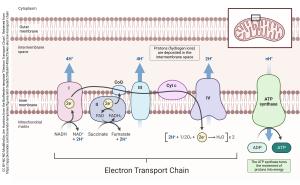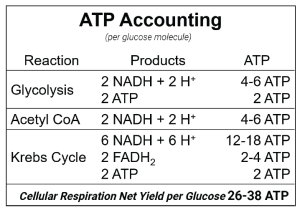The Electron Transport Chain | Oxidative Phosphorylation
Objective 5.8
5.8.1 State the essential features of the electron transport chain.
Step 4 – The Electron Transport Chain

So far, in the first three steps of cellular respiration, we have completely dismantled a glucose molecule but only generated four net ATP molecules (not a lot). The electron transport chain is where we reap the benefit of the work done in the previous three steps—the quiet work of picking up protons and electrons performed by NAD+ and FAD.
NADH + H+ and FADH2 deliver protons (H+) to the intermembrane space, and simultaneously deliver electrons (e–) to the electron transport chain.
The proteins of the electron transport chain use a quantum phenomenon called quantum tunneling to play hide-and-seek with these “high energy” electrons.
When the ATP synthase at the end of the chain makes the formerly hidden electron available to the eager protons (H+) stored in the intermembrane space, their reunion is managed in such a way that energy is created.
The creation of energy by the ATP synthase is a weird and yet wonderful process. The protons are forced into a channel that forms an almost-complete circle. As the protons make their way through this tunnel, they alter the configuration of the ATP synthase in such a way that a rotor is turned by the motion of protons. The protons then escape through the “bottom” of the almost-circular tunnel and are joined with their electrons. Every two complete (proton + electron) hydrogen atoms that are made in this way are joined to one oxygen atom to form metabolic water (H2O).
The spinning rotor is what provides the energy that is stored in the high-energy phosphate bond between phosphate and ADP and drives the formation of ATP.
Now we’re ready to see all four steps of the ATP synthesis process in one diagram again.
One final concept related to cellular respiration and ATP production: You may have noticed, as we outlined the four steps of cellular respiration, we sometimes expressed the numbers of ATP produced as a range (4-6 ATP) rather than a firm number. As amazing and critical as the cellular respiration process is, it is not perfect and is actually somewhat inefficient. In theory, each NADH + H+ can produce either two or three ATP, and each FADH2 yields either one or two ATP. Applying these ranges to the four steps of cellular respiration, we could end up with anywhere from 26 to 38 ATP per glucose. In practice, we usually get 30-32 ATP per glucose.

Media Attributions
- U05-021 Electron Transport Chain © BioRender adapted by Jim Hutchins is licensed under a CC BY-NC-ND (Attribution NonCommercial NoDerivatives) license
- U05-022 atp accounting table © Hutchins, Jim is licensed under a Public Domain license

